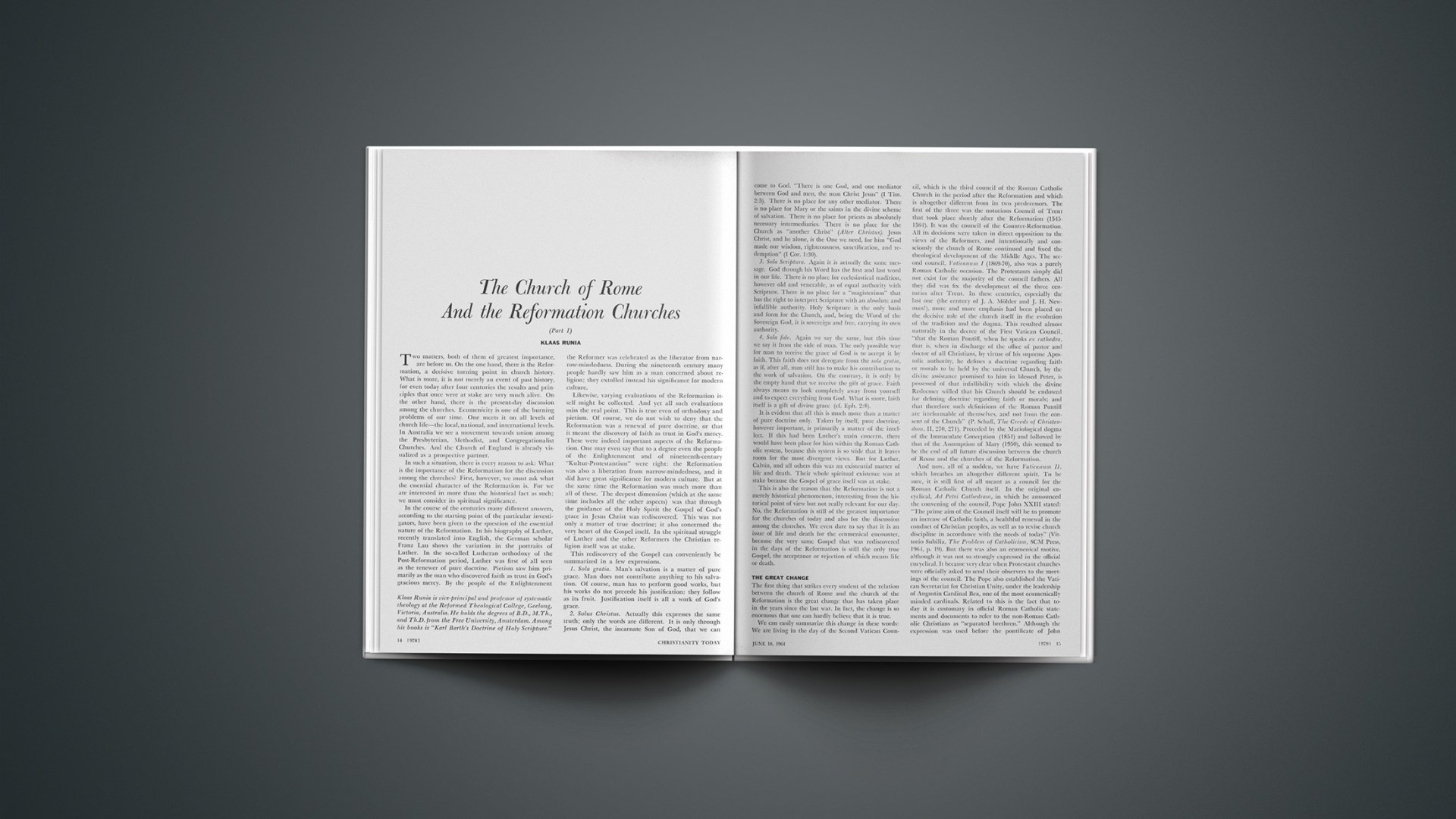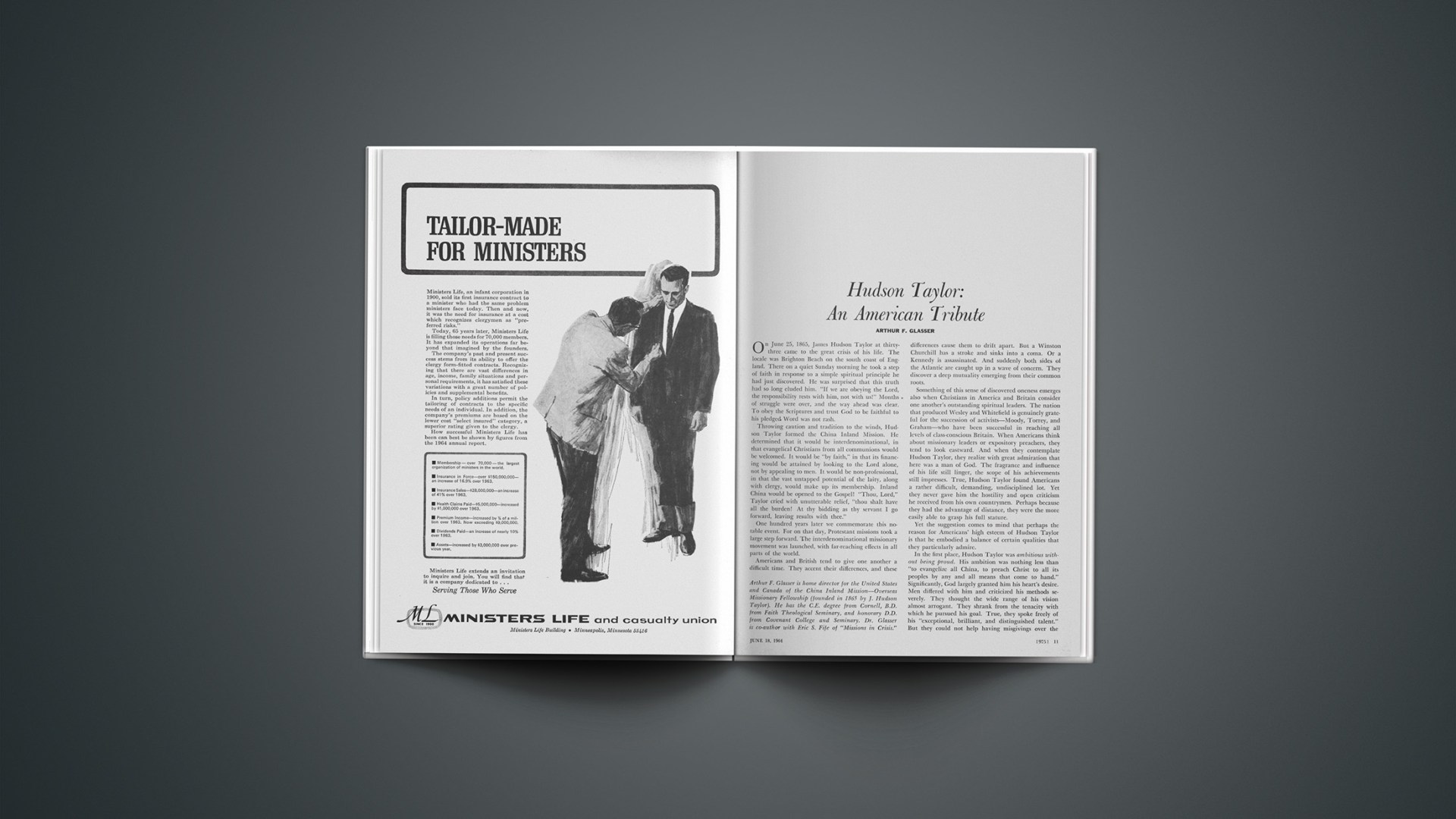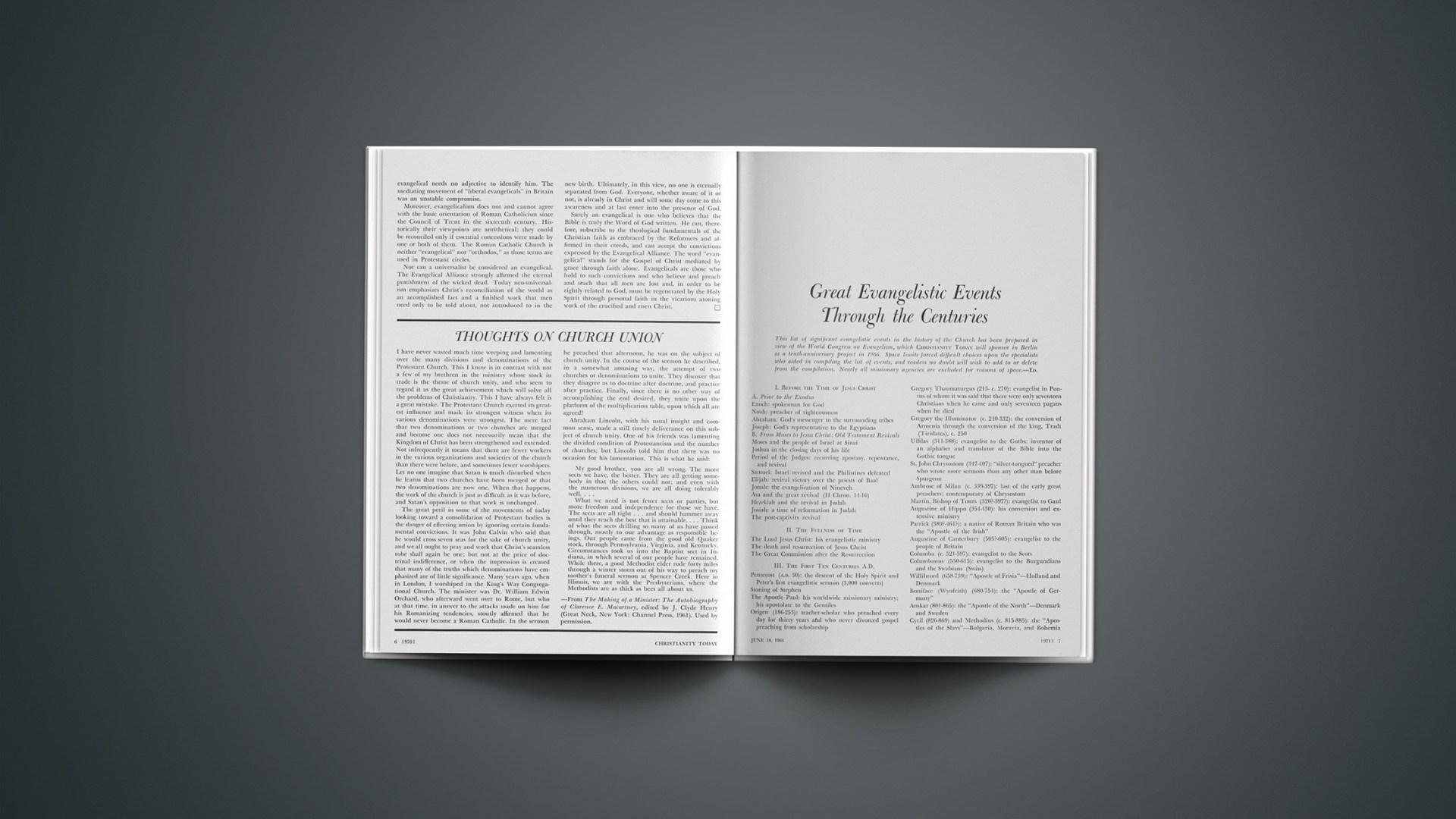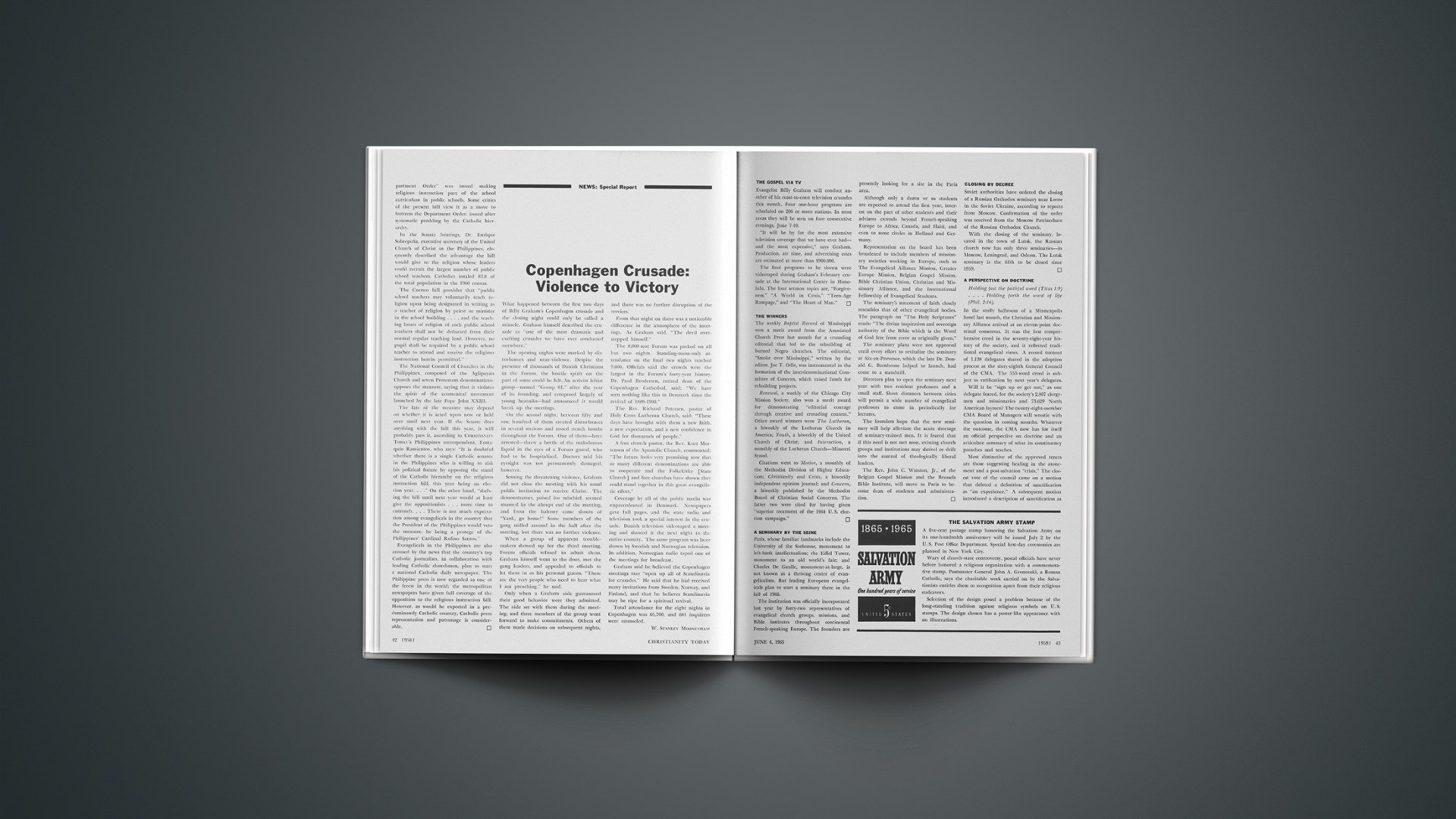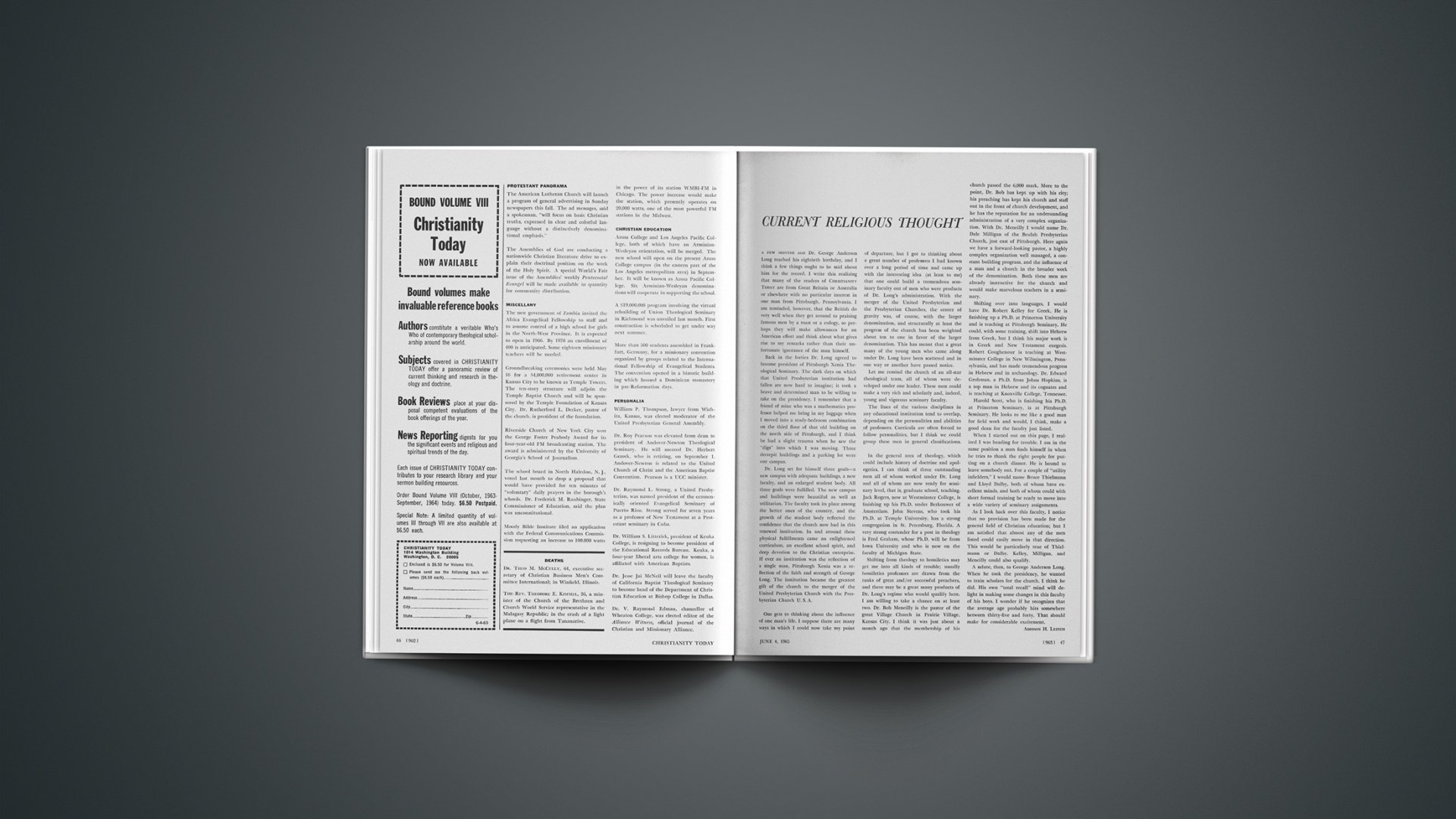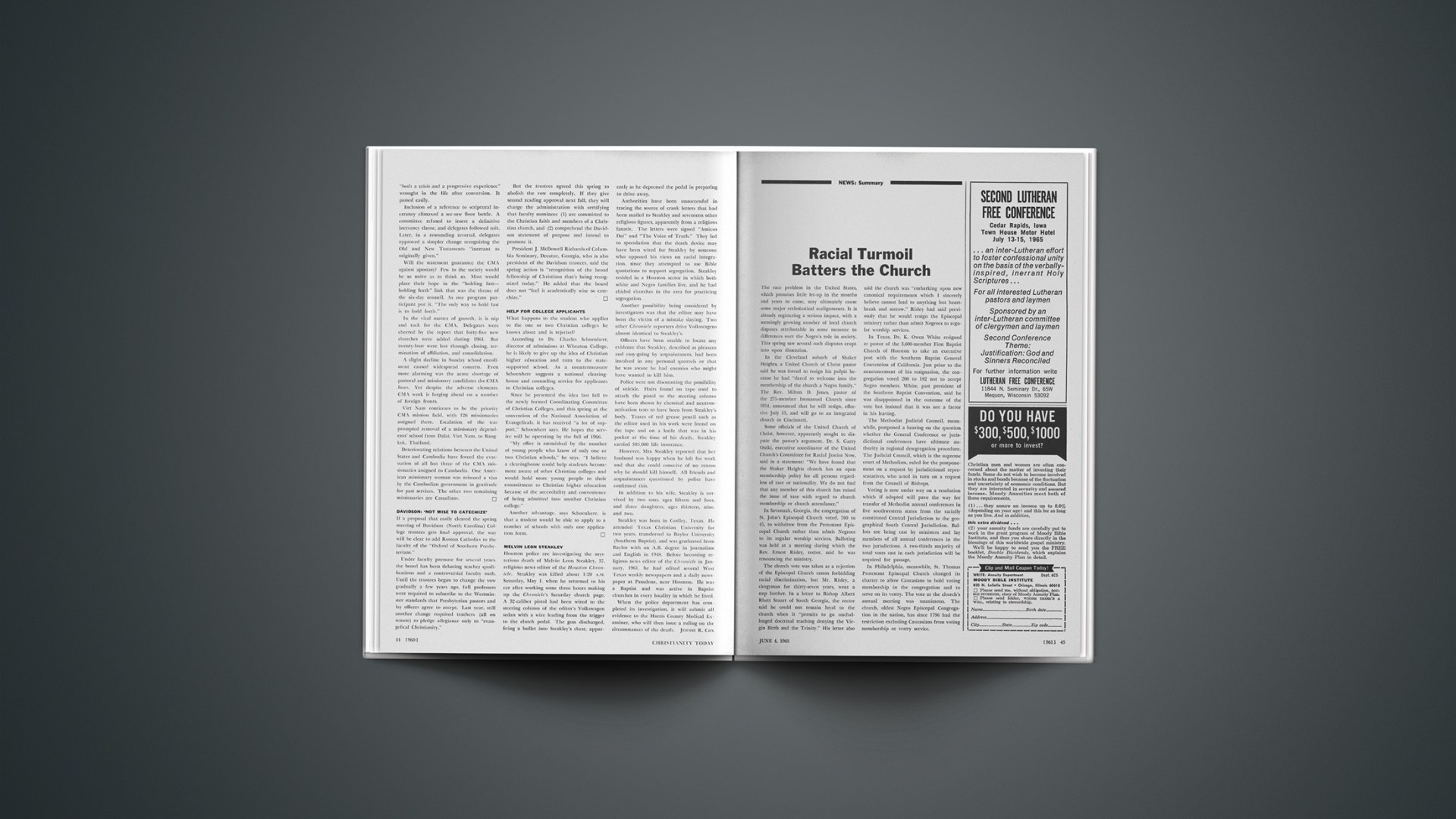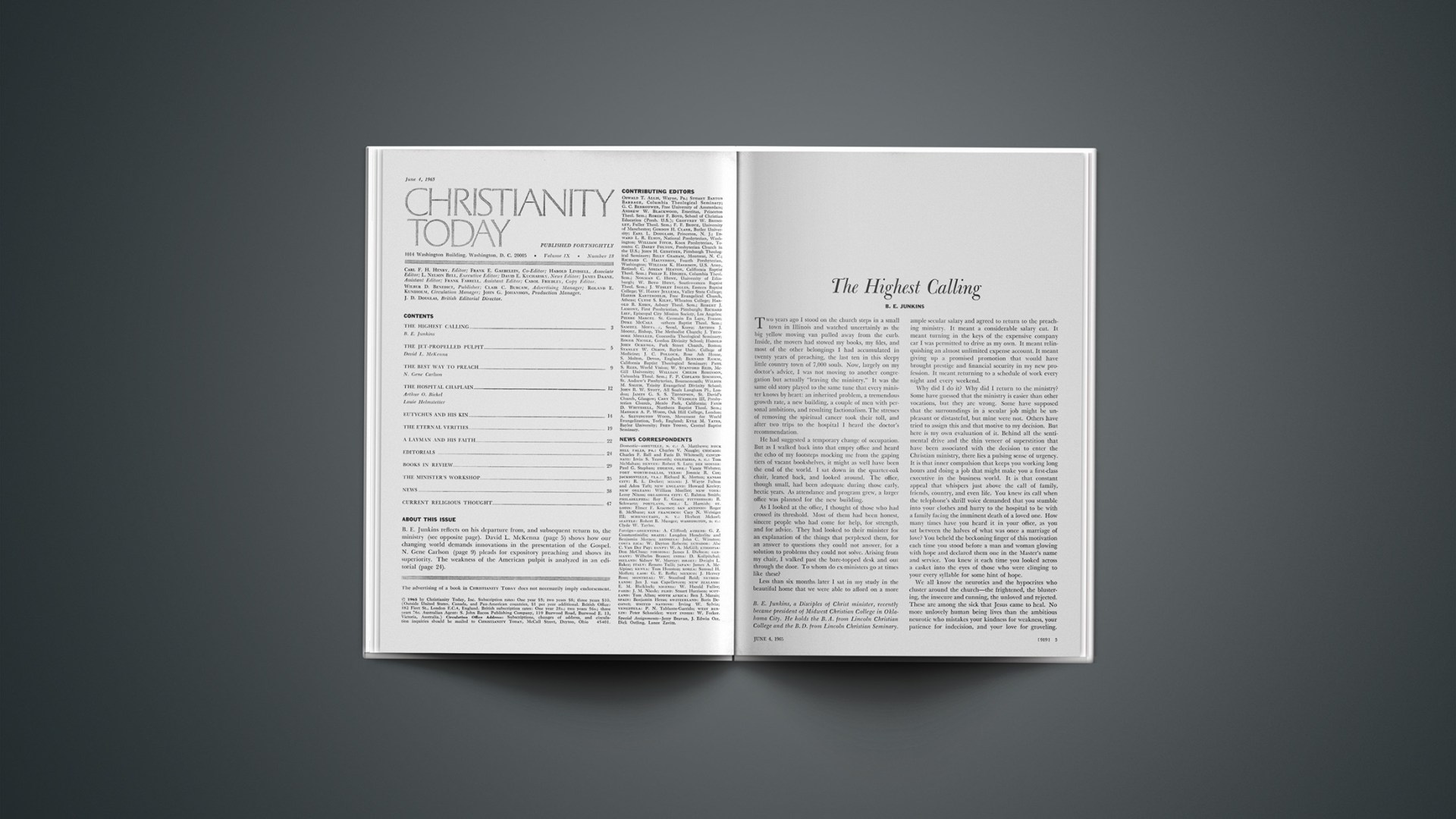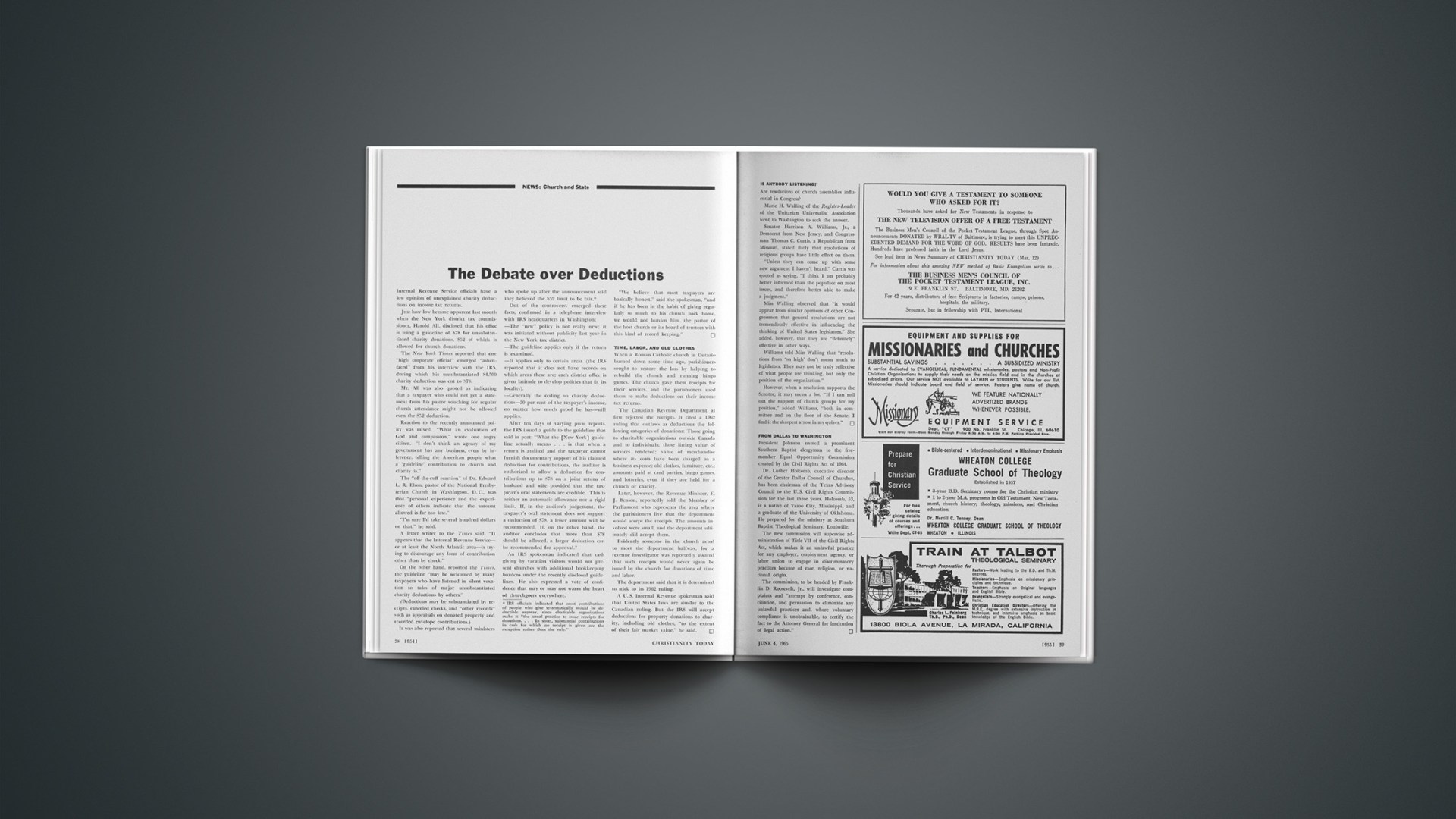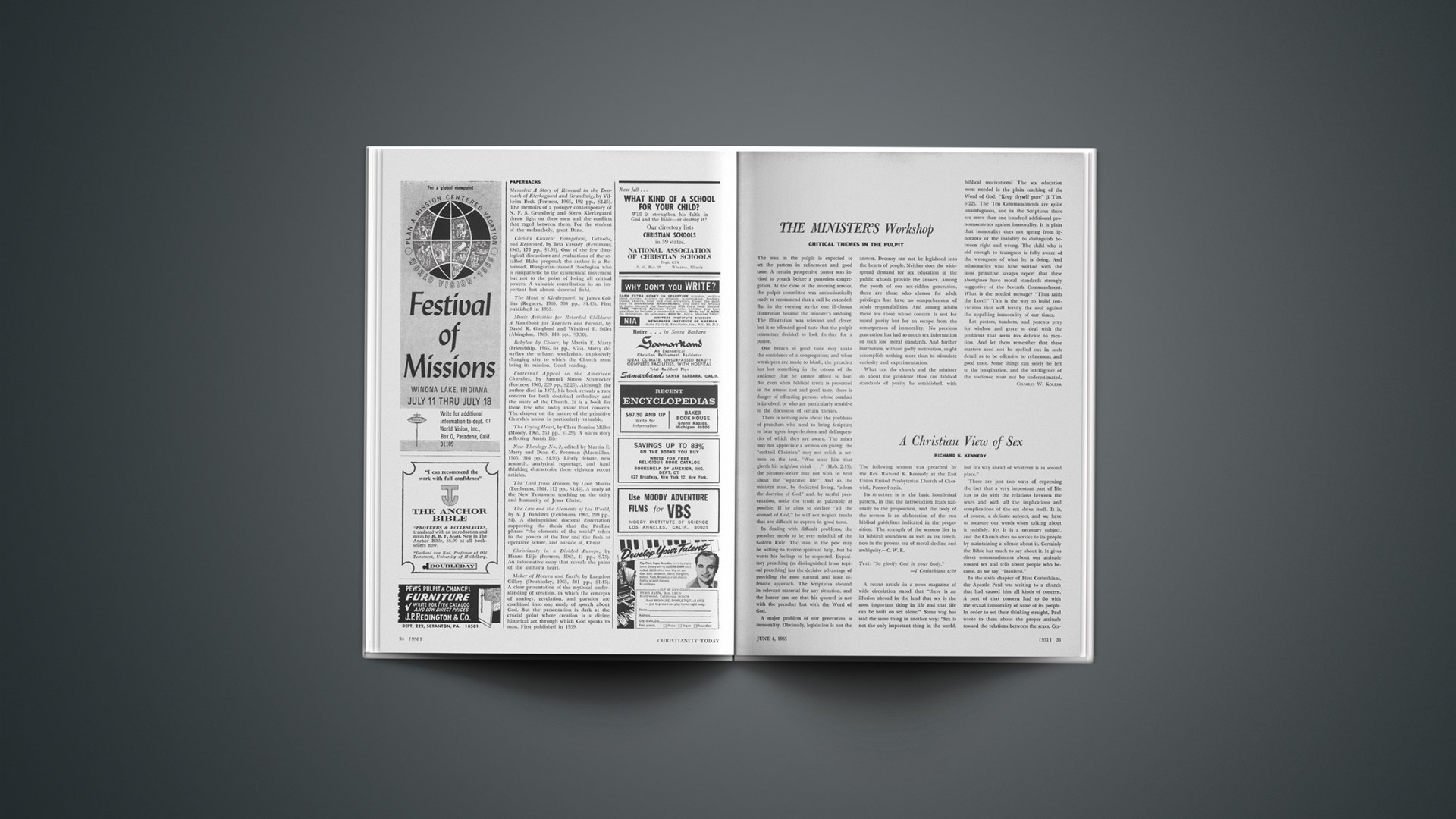(Part I)
Two matters, both of them of greatest importance, are before us. On the one hand, there is the Reformation, a decisive turning point in church history. What is more, it is not merely an event of past history, for even today after four centuries the results and principles that once were at stake are very much alive. On the other hand, there is the present-day discussion among the churches. Ecumenicity is one of the burning problems of our time. One meets it on all levels of church life—the local, national, and international levels. In Australia we see a movement towards union among the Presbyterian, Methodist, and Congregationalist Churches. And the Church of England is already visualized as a prospective partner.
In such a situation, there is every reason to ask: What is the importance of the Reformation for the discussion among the churches? First, however, we must ask what the essential character of the Reformation is. For we are interested in more than the historical fact as such; we must consider its spiritual significance.
In the course of the centuries many different answers, according to the starting point of the particular investigators, have been given to the question of the essential nature of the Reformation. In his biography of Luther, recently translated into English, the German scholar Franz Lau shows the variation in the portraits of Luther. In the so-called Lutheran orthodoxy of the Post-Reformation period, Luther was first of all seen as the renewer of pure doctrine. Pietism saw him primarily as the man who discovered faith as trust in God’s gracious mercy. By the people of the Enlightenment the Reformer was celebrated as the liberator from narrow-mindedness. During the nineteenth century many people hardly saw him as a man concerned about religion; they extolled instead his significance for modern culture.
Likewise, varying evaluations of the Reformation itself might be collected. And yet all such evaluations miss the real point. This is true even of orthodoxy and pietism. Of course, we do not wish to deny that the Reformation was a renewal of pure doctrine, or that it meant the discovery of faith as trust in God’s mercy. These were indeed important aspects of the Reformation. One may even say that to a degree even the people of the Enlightenment and of nineteenth-century “Kultur-Protestantism” were right: the Reformation was also a liberation from narrow-mindedness, and it did have great significance for modern culture. But at the same time the Reformation was much more than all of these. The deepest dimension (which at the same time includes all the other aspects) was that through the guidance of the Holy Spirit the Gospel of God’s grace in Jesus Christ was rediscovered. This was not only a matter of true doctrine; it also concerned the very heart of the Gospel itself. In the spiritual struggle of Luther and the other Reformers the Christian religion itself was at stake.
This rediscovery of the Gospel can conveniently be summarized in a few expressions.
1. Sola gratia. Man’s salvation is a matter of pure grace. Man does not contribute anything to his salvation. Of course, man has to perform good works, but his works do not precede his justification: they follow as its fruit. Justification itself is all a Work of God’s grace.
2. Solus Christus. Actually this expresses the same truth; only the words are different. It is only through Jesus Christ, the incarnate Son of God, that we can come to God. “There is one God, and one mediator between God and men, the man Christ Jesus” (1 Tim. 2:5). There is no place for any other mediator. There is no place for Mary or the saints in the divine scheme of salvation. There is no place for priests as absolutely necessary intermediaries. There is no place for the Church as “another Christ” (Alter Christus). Jesus Christ, and he alone, is the One we need, for him “God made our wisdom, righteousness, sanctification, and redemption” (1 Cor. 1:30).
3. Sola Scriptura. Again it is actually the same message. God through his Word has the first and last word in our life. There is no place for ecclesiastical tradition, however old and venerable, as of equal authority with Scripture. There is no place for a “magisterium” that has the right to interpret Scripture with an absolute and infallible authority. Holy Scripture is the only basis and form for the Church, and, being the Word of the Sovereign God, it is sovereign and free, carrying its own authority.
4. Sola fide. Again we say the same, but this time we say it from the side of man. The only possible way for man to receive the grace of God is to accept it by faith. This faith does not derogate from the sola gratia, as if, after all, man still has to make his contribution to the work of salvation. On the contrary, it is only by the empty hand that we receive the gift of grace. Faith always means to look completely away from yourself and to expect everything from God. What is more, faith itself is a gift of divine grace (cf. Eph. 2:8).
It is evident that all this is much more than a matter of pure doctrine only. Taken by itself, pure doctrine, however important, is primarily a matter of the intellect. If this had been Luther’s main concern, there would have been place for him within the Roman Catholic system, because this system is so wide that it leaves room for the most divergent views. But for Luther, Calvin, and all others this was an existential matter of life and death. Their whole spiritual existence was at stake because the Gospel of grace itself was at stake.
This is also the reason that the Reformation is not a merely historical phenomenon, interesting from the historical point of view but not really relevant for our day. No, the Reformation is still of the greatest importance for the churches of today and also for the discussion among the churches. We even dare to say that it is an issue of life and death for the ecumenical encounter, because the very same Gospel that was rediscovered in the days of the Reformation is still the only true Gospel, the acceptance or rejection of which means life or death.
The Great Change
The first thing that strikes every student of the relation between the church of Rome and the church of the Reformation is the great change that has taken place in the years since the last war. In fact, the change is so enormous that one can hardly believe that it is true.
We can easily summarize this change in these words: We are living in the day of the Second Vatican Council, which is the third council of the Roman Catholic Church in the period after the Reformation and which is altogether different from its two predecessors. The first of the three was the notorious Council of Trent that took place shortly after the Reformation (1545–1564). It was the council of the Counter-Reformation. All its decisions were taken in direct opposition to the views of the Reformers, and intentionally and consciously the church of Rome continued and fixed the theological development of the Middle Ages. The second council, Vaticanum I (1869–70), also was a purely Roman Catholic occasion. The Protestants simply did not exist for the majority of the council fathers. All they did was fix the development of the three centuries after Trent. In these centuries, especially the last one (the century of J. A. Möhler and J. H. Newman!), more and more emphasis had been placed on the decisive role of the church itself in the evolution of the tradition and the dogma. This resulted almost naturally in the decree of the First Vatican Council, “that the Roman Pontiff, when he speaks ex cathedra, that is, when in discharge of the office of pastor and doctor of all Christians, by virtue of his supreme Apostolic authority, he defines a doctrine regarding faith or morals to be held by the universal Church, by the divine assistance promised to him in blessed Peter, is possessed of that infallibility with which the divine Redeemer willed that his Church should be endowed for defining doctrine regarding faith or morals; and that therefore such definitions of the Roman Pontiff are irreformable of themselves, and not from the consent of the Church” (P. Schaff, The Creeds of Christendom, II, 270, 271). Preceded by the Mariological dogma of the Immaculate Conception (1854) and followed by that of the Assumption of Mary (1950), this seemed to be the end of all future discussion between the church of Rome and the churches of the Reformation.
And now, all of a sudden, we have Vaticanum II, which breathes an altogether different spirit. To be sure, it is still first of all meant as a council for the Roman Catholic Church itself. In the original encyclical, Ad Petri Cathedram, in which he announced the convening of the council, Pope John XXIII stated: “The prime aim of the Council itself will be to promote an increase of Catholic faith, a healthful renewal in the conduct of Christian peoples, as well as to revise church discipline in accordance with the needs of today” (Vittorio Subilia, The Problem of Catholicism, SCM Press, 1964, p. 19). But there was also an ecumenical motive, although it was not so strongly expressed in the official encyclical. It became very clear when Protestant churches were officially asked to send their observers to the meetings of the council. The Pope also established the Vatican Secretariat for Christian Unity, under the leadership of Augustin Cardinal Bea, one of the most ecumenically minded cardinals. Related to this is the fact that today it is customary in official Roman Catholic statements and documents to refer to the non-Roman Catholic Christians as “separated brethren.” Although the expression was used before the pontificate of John XXIII (we find it in early writings of Fr. Yves Congar), it has come into vogue especially through Pope John. Rome has always held that those who were baptized in the name of the triune God somehow belonged to the mystical body of Christ, though separated from the visible manifestation of this body in the Roman Catholic Church. In other words, they were separated brethren. In the past, however, the full emphasis was on the adjective. The great change of our day is that it has shifted to the noun: we are separated brethren.
All this is connected with the emergence of a new theology in the Roman Catholic Church. Over against the traditionalists with their emphasis on “integrism” i.e., the pure and simple submission to the claims of Roman authority, the return of the prodigal sons to the father’s house, stands the progressive party with its stress on “integration,” i.e., the necessity to take the gospel truths professed by non-Catholics and insert them within the framework of the Catholic system. The last view is eloquently and impressively advocated by a comparatively small avant-garde of brilliant theologians who wish to adhere faithfully to the dogma of their church but who also assert that this dogma has not in every respect achieved its complete form.
Bigger Than Trent
A striking example of this new approach is found in the doctoral thesis which the young Austrian theologian Hans Küng wrote on justification in the theology of Karl Barth and in the decrees of the Council of Trent. He freely admits that the decrees of the Council, although fully true in their foundations, were one-sidedly anti-Protestant. Catholic doctrine is bigger than Trent. On the other hand, the decrees have often been misunderstood, as if they taught “co-operation” of man with God in the act of redemption. Basically there is a place for the Lutheran simul justus et peccator (at once just and a sinner) and sola fide (by faith alone) in the Roman Catholic doctrine of justification, and therefore Karl Barth is altogether wrong in calling the Roman Catholic doctrine “another gospel.”
All this just shows how much has changed in the theological and ecclesiastical climate in the last few years. In one of its latest sessions the Vatican Council even went so far as to use the term “church” for the Protestant churches. Until recently we were called “separated brethren,” but the term “churches” was studiously avoided in official documents. Instead the word “communities” was employed. On September 29 the Melbourne Herald reported that the council had accepted the first chapter of a decree giving detailed guidance on how Roman Catholics can work more actively for Christian unity. “The new text, revised and strengthened after debate last year, refers to Protestant faiths as churches or communities. The original text described them as communities and reserved the word churches to the orthodox.”
How must we assess this amazing development? To put it in the terms of our subject, can one still speak of the “importance” of the Reformation in the discussion with Rome? The answer must be a straightforward, Yes.
One of the first requirements for a correct and balanced assessment of the new situation is a clear discernment of its various aspects. To be more exact, we have to distinguish between the present-day theological and ecclesiastical climate, on the one hand, and the essential structure of Rome and its dogma, on the other hand. There is no denying that the climate has changed considerably. In fact, it has veered completely around. And this is very important indeed. For the first time since the Reformation, Rome shows that it is willing to take the Reformation seriously. It is even willing to admit that in the churches of the Reformation aspects of truth have been retained which did not receive proper attention in Roman Catholic dogma. In other words, for the first time in four hundred years there is a real basis for discussion.
Has The Dogma Changed?
But—has Rome itself with its dogma really changed, so that one can say that the Reformation has become superfluous? Does Rome now have a real understanding of the existential protest of the Reformation? Is there any trace of a similar rediscovery of the full Gospel of grace on Rome’s side?
In his recent book, The Problem of Catholicism, Dr. Vittorio Subilia, dean of the Waldensian Theological Faculty at Rome, gives ample documentary proof that this is not the case. Admittedly, Rome is prepared for “reformism.” In fact there are many reforming tendencies in the church of Rome today. It is readily granted in Roman Catholic circles that there are “subjective faults,” requiring a reformation of life; institutional faults, requiring a cleansing of the Temple; historical faults, requiring a “de-westernizing” of Christianity; ecumenical faults, requiring a reform of the confessional psychology. The language and the intellectual framework of the Church also need to be reformed. But a dogmatical reform is an impossibility! Even the most ardent advocates of ecumenicity in the Roman Catholic Church, such as Cardinal Bea and Father Boyer, uninhibitedly speak of the immutability of the dogma. Subilia rightly says, “We must categorically exclude any reform of the sort to which Luther and Calvin called the universal Church of their days” (op. cit., p. 97).
For this reason we must reject attempts of reinterpretation, such as that of Küng. They are not really helpful but rather confuse the issue. “No real ecumenical contribution is made by this sort of approach, in which Trent’s semi-Pelagian phrases are subtly wrapped up in Augustinian ones, and by clever documentation Luther is made to look like a Catholic, and the Fathers of Trent like Lutherans, and the Catholic-Protestant antithesis is drained of its meaning and reduced to an accidental if regrettable misunderstanding that no one in four centuries had ever noticed before Dr. Küng” (Subilia, op cit., p. 41).
The Catholic-Protestant antithesis is still there in all its force and sharpness. For proof we need only to point to the Roman Catholic Mariology. This doctrine is not just a matter of popular devotion, nor something on the edge of the doctrinal system, for in it the deepest essence of the Roman Catholic conception of the Christian faith, namely, the necessity of co-redemptive mediation on the part of the creature, is expressed. G. C. Berkouwer has rightly pointed out that Mariology cannot be considered an excess that might be eliminated from Roman doctrine without affecting its heart (Conflict with Rome, 1958, p. 165). He also quotes the leading Roman Catholic theologian Scheeben, who said: “On these grounds Mary occupied a position in the divine world plan and in the dogma and the life of the church, which is as essential and universal as it is exalted and striking. And, therefore, the doctrine about her constitutes an organic part of dogmatics.” All this is still fully maintained by the Roman Catholic Church of today and also by the representatives of the “theologie nouvelle.” Pope John XXIII said in one of his addresses: “He sets in jeopardy his salvation, who tossed in the storms of this world, refuses to clasp her helping hand,” since “it is through Mary that we come to Jesus” and “to love Christ means to love Mary his Mother and, in the light of redemption, our universal Mother.” And likewise Hans Küng, though rejecting excesses of Marian devotion, nevertheless asks his Protestant brethren the following question: “Can we raise our voices in praise of Christ without also raising them in praise of her who spoke the decisive fiat to Christ? Can we be Christian without—though in a different way—being Marian too? Can we work at Christian theology without—though in a different way—working at Marian theology too?… Can there, finally, be any reunion in Christ which would leave the mystery of Mary to one side?” (The Council and Reunion, p. 187).
We have recently made a special study of the Roman Catholic doctrines of the primacy, Petrine succession, and infallibility of the pope. In our study we were struck by the fact that in the new theology they are fully maintained. There are differences of emphasis. But the pope is still “Sanctissimus Dominus noster Papa”—“our most holy Lord, the Pope.” Pope John XXIII himself left no doubt on this point. The present Pope Paul VI, in his first encyclical, Ecclesiam Suam (August, 1964), emphatically declares: “We bear the responsibility of ruling the Church of Christ, because we hold the office of Bishop of Rome and consequently the office of Successor to the Blessed Apostle Peter, the bearer of the master keys to the Kingdom of God, the Vicar of the same Christ who made of him the supreme shepherd.” In this same encyclical he warns those “separated brethren” who say that if it were not for the primacy of the pope, the reunion of the separated churches with the Catholic Church would be easy: “We beg the separated brethren to consider the inconsistency of this position, not only in that, without the Pope the Catholic Church would no longer be catholic, but also because, without the supreme, efficacious and decisive pastoral office of Peter, the unity of the church of Christ would utterly collapse. It would be vain to look for other principles of unity in place of the one established by Christ himself” (this and the above statement quoted in CHRISTIANITY TODAY, Aug. 28, 1964, p. 44).
In the light of these statements—and they could easily be augmented with many others on other doctrines—we must conclude that Rome has not fundamentally changed. There are important changes in climate, in approach, in emphases, even in aspects of truth; but the system as such has not changed.
The Church And The ‘And’
This also means, however, that the Reformation has not lost anything of its spiritual importance. To say, as some Roman Catholic ecumenists do, that it represents an insight which had been long neglected by Rome but which in our time is being incorporated into the fullness of the Roman Catholic system, is a serious misunderstanding of the Reformation. As we have said before, it was no less than a rediscovery of the Gospel of grace. And it is this Gospel of grace which we still have to hold before Rome as the real spiritual challenge. What the church of Rome needs is not “reform,” which amounts to pruning away some of the historical accretions, but “reformation,” that is, a new, completely new, understanding of the Gospel itself. Karl Barth brought all of this into sharp focus when in an interview he remarked: “In my view the greatest obstacle to rapprochement between the Reformed Church and the Catholic Church is a tiny little word which the Roman Church adds after each of our statements: the word ‘and.’ When we say Jesus, the Catholics say Jesus and Mary. We try to obey Christ as our only Lord; the Catholics obey Christ and his representative on earth, the Pope. We believe that Christians are saved by the merits of Jesus Christ; the Catholics add, ‘and by their own merits,’ i.e., by their works. We believe that the sole source of Revelation is Scripture; the Catholics add ‘and tradition.’ We say that knowledge of God is obtained through faith in his Word as expressed in the Scriptures; the Catholics add ‘and through reason’ ” (quoted by J. D. Douglas, “Reflections on a Common Heritage,” CHRISTIANITY TODAY, Oct. 11, 1963, p. 4). So long as Rome maintains this word “and”—and it is maintained even by the adherents of the new theology!—there is no reason to say that the Reformation is an antiquated historical position. In fact, it will never be such a position, because it is not primarily a historical event. Rather, it is a spiritual understanding. No one, neither Rome nor we Protestants, can ever pass by this rediscovery of the Gospel. To be a true Church of Jesus Christ we always have to begin with the a b c of the Reformation: sola gratia, solus Christus, sola Scriptura, sola fide. Without this a b c no one can spell the Gospel, and so long as Rome refuses to do this, it will have a distorted understanding of the only true Gospel, the Gospel of pure, sovereign grace in Jesus Christ.
TO BE CONTINUED
T. Leo Brannon is pastor of the First Methodist Church of Samson, Alabama. He received the B.S. degree from Troy State College and the B.D. from Emory University.

